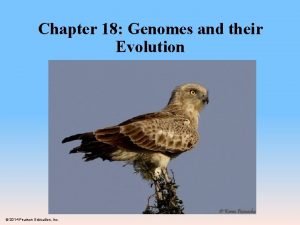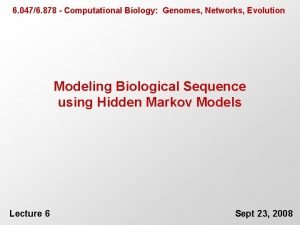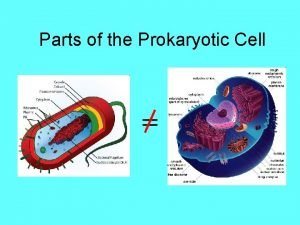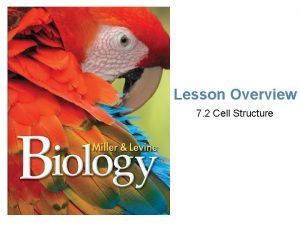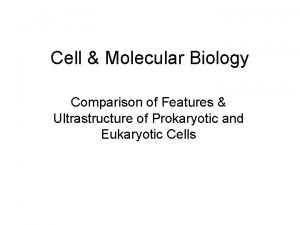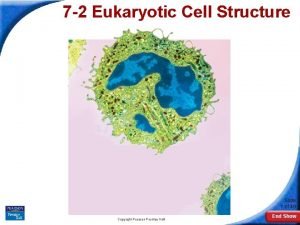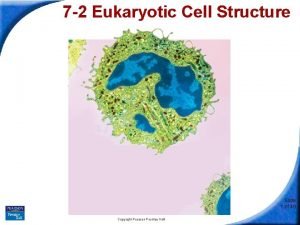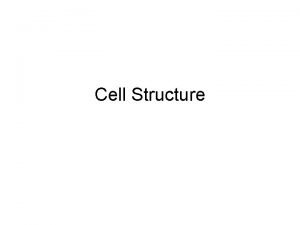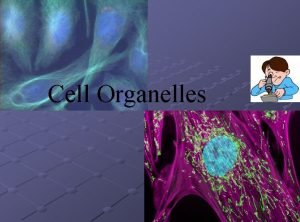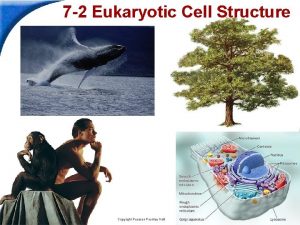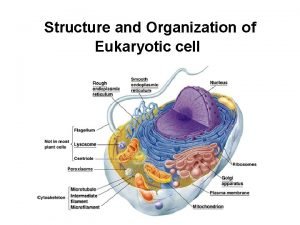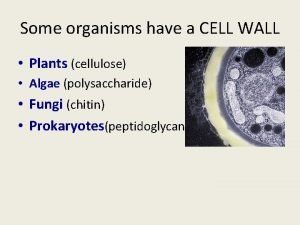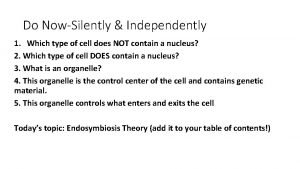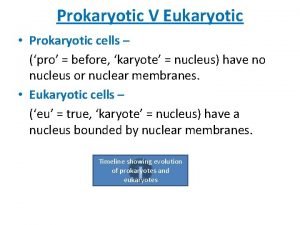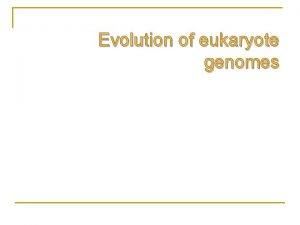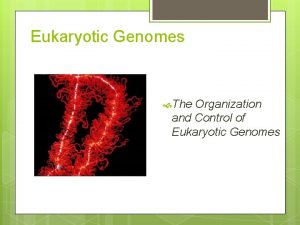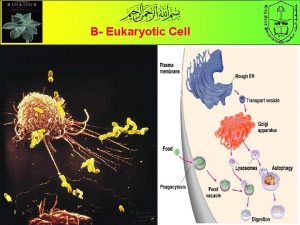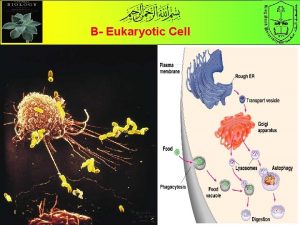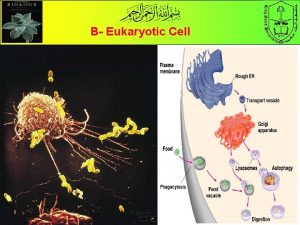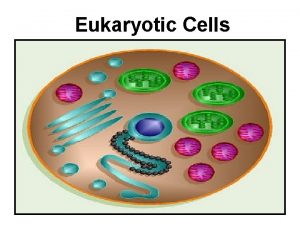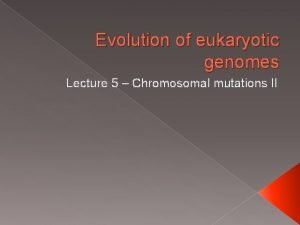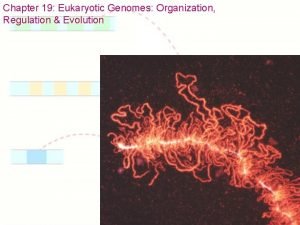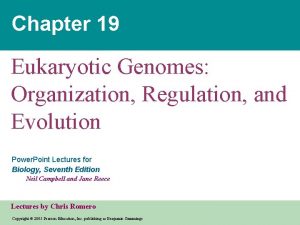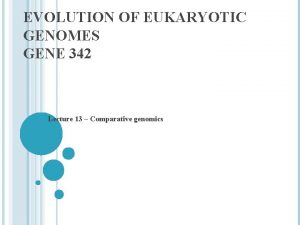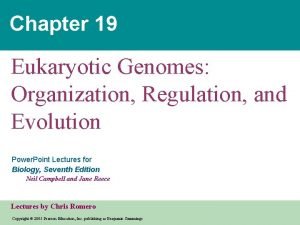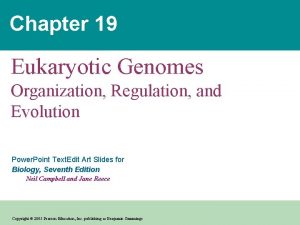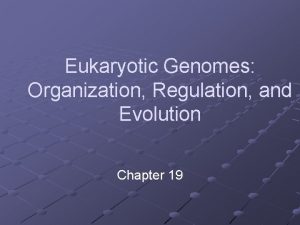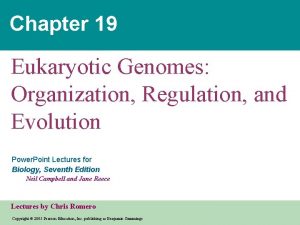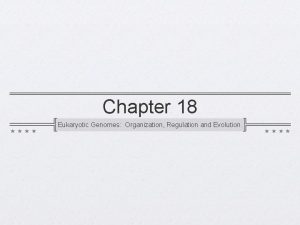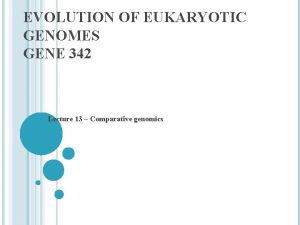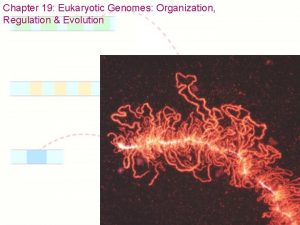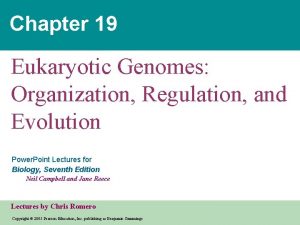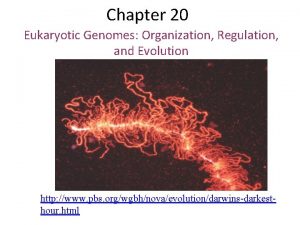Evolution of Genomes Evolution of the eukaryotic cell

























- Slides: 25

Evolution of Genomes Evolution of the eukaryotic cell Human evolution

Endosymbiotic Events n n n Mitochondria originated from Proteobacteria Chloroplasts originated from Cyanobacteria Where did the nucleus originate from?

Genomic Study of Endosymbiosis n n n Takao Shinozawa’s group in Japan compared orthologs between yeast an either eubacteria or archaea. E-values are represented as -log E (the larger the # the better E-value). The bit scores get larger as the E-values decrease, resulting in a lower # of hits (lines have - slope) A t-statistic test was performed comparing data from the two domains. A t-stat of > 1. 771 indicates Archaeal origin, while a value of < -1. 771 indicates Eubacteria.

Mitochondrial Genes Originated from Eubacteria t-stats are < -1. 771 for most E-values

Nuclear Genes Originated from Archaebacteria t-stats are > 1. 771 for most E-values

Cytoplasmic Genes Show No Distinct Origin t-stats are sometimes > 1. 771 and sometimes < -1. 117

t-statistics In the mitochondrial example, the values at an Evalue of 10 -5 were 12, 15, 19, 21 , 24 & 27 for Archaea and 65, 66, 68, 73, 75, 80, 81, 82 & 93 for Eubacteria. We then determine the sample size (n), the mean (y), and the standard deviation (s) for each. n The standard deviations are then pooled using: sp = sq rt [((n 1 - 1) s 12 + (n 2 -1) s 22)/(n 1 + n 2 -2)] n The t-statistic is then determined by: t = (y 1 - y 2)/(sp * sq rt [1/ n 1 + 1/ n 2] In this case, t < -1. 771 (Eubacterial origin) n

Existing organisms may provide information on “missing-links” between bacteria and eukaryotes Buchnera M. leprae

Buchnera n n n All animals, with the exception of aphids, excrete toxic nitrogenous waste Aphids have 60 -80 large cells in their abdomens called bacteriocytes Bacteria called Buchnera inhabit this organ Neither organism can reproduce without the other Their symbiotic relationship is thought to date back 225 million years

The Buchnera Genome n n n At 640, 681 bp, it is the 2 nd smallest sequenced Contains 583 genes 500 are very similar to E. coli, 79 are related to other bacterial, only 4 are unique to Buchnera Many genes which are non-essential to the symbiotic relationship have been lost over time Buchnera can only synthesize amino acids which aphids are unable to produce

Types of genes which Buchnera lack n n DNA repair enzymes cell wall synthesizing enzymes involved in phospholipid synthesis components of signaling pathways Types of genes which Buchnera have n n certain amino acid synthesis certain vitamin synthesis ATP synthase ETC


Buchnera acts as if it is evolving into a new organelle n n It uses glutamine as a substrate to make essential amino acids, hence no nitrogenous waste is produced Someday it may be completely engulfed by cells as an “aminoacid-plast”

Mycobacterium leprae n n n The causative agent of leprosy Lives inside macrophages and myelinproducing Schwann cells Still infects many people, mostly in 3 rd world countries Unable to be cultured in the laboratory Must be grown in the nine-banded armadillo The bacterium divides once every 14 days

The M. leprae Genome n n n Contains 3. 3 million bp (compared to the 4. 4 million of M. tuberculosis) Encodes 1, 600 proteins (compared to 4, 000) Only 50% of genome codes for proteins The rest is pseudogenes (1100 in number) Other genes appear to have been replaced by orthologs

Pseudogenes in M. leprae

M. leprae vs. M. tuberculosis Genes lacking in M. leprae n n certain membrane lipids genes involved in TCA and glycolysis malic enzyme methionine synthesis

Slow-growing organisms which have lost many genes but can still live independently represent one more step in the production of an organelle

Human Evolution 3000 bp of nuclear sequence was used to create phylogenetic trees. Humans are closely related to the great apes. The base of the mammalian tree is a Tree shrew.


Bootstrap Analysis n 1) 2) n n n How do we know that a tree is right? use different methods to create the tree: distancebased, maximum parsimony, etc. use bootstrap analysis Bootstrapping repeats the tree-building process thousands of times using different subsequences The percent of times that a branch point agrees in the various replicates becomes its bootstrap value A bootstrap value > 70 is considered reliable

How much diversity is there among groups of primates? 10, 000 bp of non-coding DNA from X chromosomes of various primates was compared. The MRCA (Most Recent Common Ancestor) was determined for each. n MRCA for humans was 540, 000 years ago n MRCA for gorilla was 1. 2 million years ago n MRCA for chimps was 1. 9 m years ago n MRCA for orangutans was 2. 1 m years ago Humans were seen to have less diversity than any of the great apes since Neanderthals have become extinct.

Where and when did modern humans evolve? One theory: “recent Africa hypothesis” predicts African origin 100, 000 -200, 000 years ago. n Another theory: “multiregional hypothesis” predicts a gradual evolution at sites around the world. Genomic data from mitochondria (16, 500 bp) were compared between people from diverse locations. A phylogenetic tree reveals how long it has been since African and non-African populations converged. The MRCAs for various populations can be determined n


The origin and dispersal of humans MRCA for Africans and non-Africans was 52, 000 +/- 27, 500 years n MRCA for all modern humans was 171, 500 +/50, 000 years These data support the recent Africa hypothesis n
 Chapter 18 genomes and their evolution
Chapter 18 genomes and their evolution Computational biology: genomes, networks, evolution
Computational biology: genomes, networks, evolution Site:slidetodoc.com
Site:slidetodoc.com Prokaryotic cell and eukaryotic cell similarities
Prokaryotic cell and eukaryotic cell similarities Prokaryotic cell and eukaryotic cell
Prokaryotic cell and eukaryotic cell Eukaryotic cell animal cell
Eukaryotic cell animal cell What organisms are made of eukaryotic cells
What organisms are made of eukaryotic cells Eukaryotic plant cells
Eukaryotic plant cells Parts of a prokaryotic cell
Parts of a prokaryotic cell Cell structure
Cell structure Saclike structure that stores materials
Saclike structure that stores materials Biology chapter 7 cell structure and function
Biology chapter 7 cell structure and function Typical eukaryotic cell
Typical eukaryotic cell 7-2 eukaryotic cell structure
7-2 eukaryotic cell structure 7-2 eukaryotic cell structure
7-2 eukaryotic cell structure Eukaryotic cell organisation
Eukaryotic cell organisation Cytoskeleton prokaryotic or eukaryotic
Cytoskeleton prokaryotic or eukaryotic Eukaryotic cell structure
Eukaryotic cell structure Fungi locomotion present or absent
Fungi locomotion present or absent Protien pump
Protien pump Eukaryotic cell
Eukaryotic cell Plants are multicellular eukaryotes
Plants are multicellular eukaryotes Plant cell
Plant cell Cell organelle
Cell organelle Prokaryotic and eukaryotic difference
Prokaryotic and eukaryotic difference Algae classification
Algae classification
